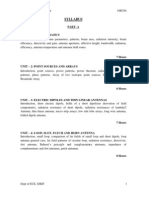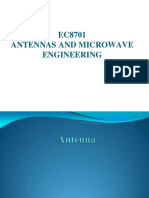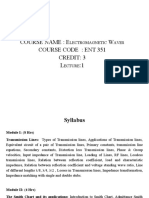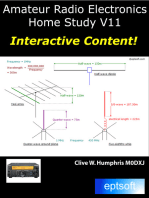Antenna and Wave
Antenna and Wave
Uploaded by
rkhanna1965Copyright:
Available Formats
Antenna and Wave
Antenna and Wave
Uploaded by
rkhanna1965Copyright
Available Formats
Share this document
Did you find this document useful?
Is this content inappropriate?
Copyright:
Available Formats
Antenna and Wave
Antenna and Wave
Uploaded by
rkhanna1965Copyright:
Available Formats
Antennas and wave propagation
LTP 312 Introduction: Antenna as an element of wireless communication system, antenna radiation mechanism, types of antennas, fundamentals of EMFT: Maxwells equations and their applications to antennas, Review of vector theory, Del operator, gradient, divergence & curl, coordinate system: rectangular, cylindrical, spherical and their transformation. Basic Antenna parameters: Antenna parameters: radiation pattern (polarization pattern, field and phase pattern). Field regions around antenna, Radiation intensity, Beam width. Gain, Directivity, polarization, bandwidth, reciprocity theorem, efficiency and antenna temperature. Antenna as a receiver: Effective height, Effective aperture, power delivered to antenna as a receiver, input impedance and friss transmission equation Properties of uniform plane waves, Retarded vector and scalar potential. Radiation from an infinitesimal small current element, radiation from an elementary dipole (Hertzian dipole).reactive, induction and radiation fields. Power density and radiation resistance for small current element and half wave dipole in fraunhauffer region Radiating Wire Structures: Monopole, dipole, Folded dipole, loop antenna and Biconical broadband Antenna Introduction to Antenna Arrays: Effect of ground on antenna performance (ground as a perfect electric conductor and lossy conductor. Linear Uniform Array of Two & Isotropic sources, Principles of pattern multiplication. Broadside arrays, End fire arrays. Array pattern Synthesis, Uniform Array, Binomial Array. Chebyshev Arrays.Antenna for receiving and transmitting TV signals e.g. Yagi-Uda and Turnstile Antennas. Aperture Type Antennas: Aperture Antennas, E & H -plane Horns, Pyramidal Horn. Lens Antenna and Reflector Antennas, Frequency Independent Antennas: Log Periodic Antenna, Microstrip Antennas & their advantages. Antenna Measurements: Antenna range, radiation pattern, gain, directivity, radiation efficiency, impedance , polarization and current measurements Propagation of Radio Waves: Different modes of propagation: Ground waves, space waves, space wave propagation over flat and curved earth, optical and radio horizons, surface waves and Troposphere waves. Ionosphere, Wave propagation in the Ionosphere. Critical frequency, Maximum usable frequency (MUF), skips distance. Virtual height. Radio noise of terrestrial and extraterrestrial origin.
Computer Based Experiments: Plot of 2D & 3D radiation pattern of short dipole, halfwave dipole in rectangular as well as polar coordinates. Simulation of beam pattern of broadside, end fire, binomial, chebyshev arrays. The simulation can be done using Matlab or Mathematica. Programme for circulating free space path loss TEXTBOOK 1. Ballanis , "Antenna Theory " , John Wiley & Sons, second edition , 2003.
REFERENCES 1. John D.Kraus and Ronalatory Marhefka, "Antennas", Tata McGraw-Hill Book Company, 2002. 2. R.E.Collins, 'Antennas and Radio Propagation ", McGraw-Hill, 1987. 3. E.C.Jordan and Balmain, "Electro Magnetic Waves and Radiating Systems", PHI, 1968, Reprint 2003.
You might also like
- Ec2353 Awp PDFDocument137 pagesEc2353 Awp PDFAdhra AllyNo ratings yet
- AntennaDocument4 pagesAntennanareshkr84No ratings yet
- Awp 1Document37 pagesAwp 1Pavan Yashoda PkNo ratings yet
- Code: ECT311 Antenna & Wave Propagation Credit: 04 L-T-P: (3-0-2) Course ContentDocument1 pageCode: ECT311 Antenna & Wave Propagation Credit: 04 L-T-P: (3-0-2) Course ContentSubhash Chandra SahuNo ratings yet
- Antennas SyllabusDocument3 pagesAntennas SyllabusPavan KumarNo ratings yet
- Ee6602 Unit IDocument32 pagesEe6602 Unit IMADHINI BALAMURALI ECENo ratings yet
- Ec1352 Antennas and Wave Propagation SyllabusDocument2 pagesEc1352 Antennas and Wave Propagation SyllabusanirobbyNo ratings yet
- Antennas and Wave PropagationDocument2 pagesAntennas and Wave PropagationkivetiNo ratings yet
- Antennas and Wave Propagationyl SDocument1 pageAntennas and Wave Propagationyl SSayyapureddi SrinivasNo ratings yet
- Antennas and Wave PropagationDocument3 pagesAntennas and Wave PropagationShiva PrasadNo ratings yet
- AwpDocument137 pagesAwpJeslin AntonioNo ratings yet
- EC-303 Antenna and Wave Propagation: Text BooksDocument1 pageEC-303 Antenna and Wave Propagation: Text Bookskhushi63No ratings yet
- Antenna SyllabusDocument2 pagesAntenna SyllabusGautami SumanNo ratings yet
- Ec-305: Antenna & Wave PropagationDocument1 pageEc-305: Antenna & Wave PropagationkhananuNo ratings yet
- Antennas and Wave PropagationDocument3 pagesAntennas and Wave PropagationArockia RajaNo ratings yet
- Notes of Antenna and Wave PropagationDocument136 pagesNotes of Antenna and Wave PropagationSachin Behl100% (2)
- Antennas and Wave PropagationDocument2 pagesAntennas and Wave PropagationmuralitmpsNo ratings yet
- AWP NotesDocument137 pagesAWP NotesSebastin SureshNo ratings yet
- Antennas & Wave PropagationDocument328 pagesAntennas & Wave PropagationAstha UnadkatNo ratings yet
- VIKAS College of Engineering & Technology, Vijayawada VIKAS Group of Institutions, VijayawadaDocument2 pagesVIKAS College of Engineering & Technology, Vijayawada VIKAS Group of Institutions, VijayawadaRajeshNo ratings yet
- Ece Vi Antennas and Propagation (10ec64) NotesDocument110 pagesEce Vi Antennas and Propagation (10ec64) Notessaifz2012100% (3)
- Antenna and Wave PropagationDocument73 pagesAntenna and Wave PropagationJULIETHERESE M100% (1)
- Antenna SyllabusDocument2 pagesAntenna SyllabusHimanshu ChauhanNo ratings yet
- Awp Syllabus SoftDocument3 pagesAwp Syllabus Softpriyakanthr5883No ratings yet
- Antenna Fundamentals and RadiationsDocument28 pagesAntenna Fundamentals and RadiationsElisha NdhlovuNo ratings yet
- Ec2353 AwpDocument137 pagesEc2353 AwpNirmalyaMazumdarNo ratings yet
- AWP Full Printed Ktunotes - inDocument111 pagesAWP Full Printed Ktunotes - inMariam FatimaNo ratings yet
- Unit 1 - INTRODUCTION TO Microwave Systems and ANTENNADocument47 pagesUnit 1 - INTRODUCTION TO Microwave Systems and ANTENNAVanitha R100% (1)
- Antenna FundamentalsDocument25 pagesAntenna Fundamentalsshuvominhaj9No ratings yet
- EC602 - Antenna & Wave PropagationDocument5 pagesEC602 - Antenna & Wave PropagationGeoffrey AlleyneNo ratings yet
- AWP Syllabus R-09Document3 pagesAWP Syllabus R-09ganesh4u_pNo ratings yet
- AntennaDocument34 pagesAntennaFab 14No ratings yet
- Antennas & Wave Propagation: B.Tech (Iii Year - I Sem)Document144 pagesAntennas & Wave Propagation: B.Tech (Iii Year - I Sem)Jayant Kumar AryaNo ratings yet
- Ec2353 Antennas and Wave PropagationDocument1 pageEc2353 Antennas and Wave PropagationHenri DassNo ratings yet
- EEDXXX - Advanced ElectromagneticsDocument2 pagesEEDXXX - Advanced Electromagneticsnaveenbabu19No ratings yet
- AWP Lecture Notes-MIMPDocument110 pagesAWP Lecture Notes-MIMPdesai vijayendra100% (1)
- Antenna Theory & Propagation (EC 604A)Document2 pagesAntenna Theory & Propagation (EC 604A)JamiNo ratings yet
- Unit I: Anteena FundamentalsDocument4 pagesUnit I: Anteena FundamentalsthrisulNo ratings yet
- 5.AWP R19 SyllabusDocument3 pages5.AWP R19 SyllabusAshoka Womens Engineering College KurnoolNo ratings yet
- AWP Lecture Notes-FinalDocument110 pagesAWP Lecture Notes-FinalgopichandNo ratings yet
- Ece Vi Antennas and Propagation (10ec64) NotesDocument112 pagesEce Vi Antennas and Propagation (10ec64) NotesMuhammad Ali ShoaibNo ratings yet
- Winsem2012-13 ... Syb Ant SybDocument2 pagesWinsem2012-13 ... Syb Ant Sybhim92No ratings yet
- Electromagnetics & Antennas: Unit IDocument1 pageElectromagnetics & Antennas: Unit IVimal Kumar SharmaNo ratings yet
- VIT UNIVERSITY SYLLABUS Ece306 Antennas and Wave PropagationDocument2 pagesVIT UNIVERSITY SYLLABUS Ece306 Antennas and Wave Propagationdivyank50% (2)
- Antenna Theory & Techniques-2 Unit-ProbsDocument41 pagesAntenna Theory & Techniques-2 Unit-Probsmuvin236No ratings yet
- Antenna and Wave PropagationDocument3 pagesAntenna and Wave PropagationPushpendra Singh Rathore0% (1)
- 1) Ec8701 Antennas and Microwave EngineeringDocument35 pages1) Ec8701 Antennas and Microwave EngineeringBALAJI VIGNESH L KNo ratings yet
- Antennas and Wave Propagation-II MarksDocument33 pagesAntennas and Wave Propagation-II MarksBRINDHASHINEY100% (2)
- 16 Ec632Document2 pages16 Ec632Davidsiño Andresiño VarelaNo ratings yet
- Awp Study MaterialDocument151 pagesAwp Study MaterialjeevaNo ratings yet
- 08Document1 page08januaryrekh630No ratings yet
- Notes 1Document249 pagesNotes 1Sefa Ocakli0% (1)
- Antenna and Radar EngineeringDocument141 pagesAntenna and Radar EngineeringArun Singh Sumbria100% (1)
- Ame Unit 1Document91 pagesAme Unit 1Kamesh0% (1)
- Fundamentals of Antenna - pptx-1Document18 pagesFundamentals of Antenna - pptx-1paulkani-ece100% (1)
- 1-Transmission Line TypesDocument20 pages1-Transmission Line TypesManish YadavNo ratings yet
- Overview of The Program 14 May 2016Document28 pagesOverview of The Program 14 May 2016rkhanna1965No ratings yet
- Microwave Devices and Circuits - Samuel Y. LiaoDocument101 pagesMicrowave Devices and Circuits - Samuel Y. Liaorkhanna1965No ratings yet
- Tut 6Document2 pagesTut 6rkhanna1965No ratings yet
- Tutorial 3Document3 pagesTutorial 3rkhanna1965No ratings yet
- TUT11Document2 pagesTUT11rkhanna1965No ratings yet
- RectennaDocument4 pagesRectennarkhanna1965No ratings yet
- Thapar University Patiala Antenna and Wave Propagation (UEC601) Tut # 1Document1 pageThapar University Patiala Antenna and Wave Propagation (UEC601) Tut # 1rkhanna1965No ratings yet
- Procedure For Taking Radiation Patterns Using Antenna Measurement Utility Software and VNADocument12 pagesProcedure For Taking Radiation Patterns Using Antenna Measurement Utility Software and VNArkhanna1965No ratings yet
- Antenna TutorialDocument4 pagesAntenna Tutorialrkhanna1965No ratings yet
- Quiz On AntennaDocument2 pagesQuiz On Antennarkhanna1965No ratings yet
- APH BLM APHgw 13 14gWGgewDocument174 pagesAPH BLM APHgw 13 14gWGgewanon_30265319No ratings yet
- Abet Cen Self StudyDocument384 pagesAbet Cen Self Studyrkhanna1965No ratings yet
- Preparing The EAC Self StudyDocument42 pagesPreparing The EAC Self Studyrkhanna1965No ratings yet
- 11 SC 2010Document2 pages11 SC 2010rkhanna196520% (5)
- AICTE Electronics Comm EnggDocument111 pagesAICTE Electronics Comm Enggrkhanna1965No ratings yet
- Electronics & Communication Engineering Department Thapar University Assignments in Space Time Wireless CommunicationDocument1 pageElectronics & Communication Engineering Department Thapar University Assignments in Space Time Wireless Communicationrkhanna1965No ratings yet
- Exam 2Document1 pageExam 2rkhanna1965No ratings yet
- CA-II Lab03 UpdatedDocument10 pagesCA-II Lab03 UpdatedLovely JuttNo ratings yet
- Fundamental Parameters of AntennaDocument19 pagesFundamental Parameters of Antennaihab411No ratings yet
- Harq in Lte: Difference Between ARQ and HARQ ArqDocument3 pagesHarq in Lte: Difference Between ARQ and HARQ ArqMahesh PratapNo ratings yet
- Ds Opa65rbu6d v1 - 3 200607Document15 pagesDs Opa65rbu6d v1 - 3 200607JEGPTHGNo ratings yet
- Keygen Dan Serial Number Seluruh ProductDocument13 pagesKeygen Dan Serial Number Seluruh ProductRhegindNo ratings yet
- Cmyk 100 66 0 2: Mobile Radio User GuideDocument9 pagesCmyk 100 66 0 2: Mobile Radio User GuideMario Javier GonzalesNo ratings yet
- FT-891 Serv 2017Document99 pagesFT-891 Serv 2017Toplician AdrianNo ratings yet
- ESB Products Catalogue 2024Document158 pagesESB Products Catalogue 2024solid.emea.hqNo ratings yet
- Antenna Mid SemDocument7 pagesAntenna Mid SemNana Agyeman Antwi100% (1)
- Chlorine and PH Correction DiagramDocument1 pageChlorine and PH Correction DiagramGerardo RubiraNo ratings yet
- Cavity Duplexer: Eleading Technologies LTDDocument14 pagesCavity Duplexer: Eleading Technologies LTDvictory_1410No ratings yet
- Bio SPDocument2 pagesBio SPbalamurugan eceNo ratings yet
- ES 442 Homework #9: SolutionsDocument6 pagesES 442 Homework #9: SolutionsAbdul RehmanNo ratings yet
- UntitledDocument119 pagesUntitledmegamaster0987654321No ratings yet
- Das 040 0001Document2 pagesDas 040 0001Alvaro TeixeiraNo ratings yet
- Unique Single Box Multi-Band Solution: AviatDocument33 pagesUnique Single Box Multi-Band Solution: AviatAlmamata Ghsa99set100% (1)
- HUAWEI Ascend P1 LTE U9202L Maintenance ManualDocument90 pagesHUAWEI Ascend P1 LTE U9202L Maintenance ManualDayronToroNo ratings yet
- MOTOTRBO Repeater Spec Sheet - AC3!02!007Rev.4Document2 pagesMOTOTRBO Repeater Spec Sheet - AC3!02!007Rev.4jlexsiNo ratings yet
- Bits Signals and PacketsDocument98 pagesBits Signals and PacketsrashidNo ratings yet
- Faculty Profile SA 2019 AugDocument3 pagesFaculty Profile SA 2019 Augpavanmp100% (2)
- 2M EIC1999 Exam Answers: Part ADocument2 pages2M EIC1999 Exam Answers: Part Aaaroncete14No ratings yet
- Wavence 18A What Is NewDocument78 pagesWavence 18A What Is NewLak niam NzikeNo ratings yet
- 275 053 Dayton Audio ND25FN 4 SpecificationsDocument1 page275 053 Dayton Audio ND25FN 4 SpecificationsjoseNo ratings yet
- Radio Controlled Travel Clock Users' Instructions: Getting StartedDocument2 pagesRadio Controlled Travel Clock Users' Instructions: Getting Startedtokuro_22No ratings yet
- BÁO CÁO THÍ NGHIỆM TÍN HIỆU HỆ THỐNG lap56Document12 pagesBÁO CÁO THÍ NGHIỆM TÍN HIỆU HỆ THỐNG lap56Văn Minh PhanNo ratings yet
- P600 AEW Brochure Ingles LOWDocument17 pagesP600 AEW Brochure Ingles LOWMarcos Antonio Ribeiro JuniorNo ratings yet
- ANR Feature HuaweiDocument36 pagesANR Feature Huaweichapulincaracandao50% (2)
- NEC IDU IPASOLINK 400A Minimum ConfigurationDocument5 pagesNEC IDU IPASOLINK 400A Minimum ConfigurationNakul KulkarniNo ratings yet
- PAS GANJIL SMA IP YAKIN B.iNGGRISDocument5 pagesPAS GANJIL SMA IP YAKIN B.iNGGRISDaswati DaswatiNo ratings yet
- Advanced Digital Signal Processing L1Document60 pagesAdvanced Digital Signal Processing L1dhurgham zwaidNo ratings yet










































































































